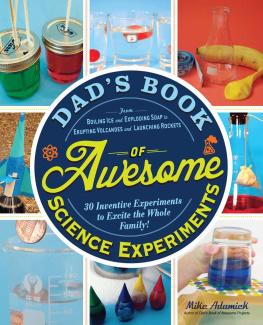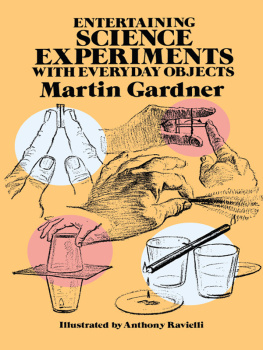
PRINCETON UNIVERSITY PRESS PRINCETON AND OXFORD

Copyright 2012 by Princeton University Press
Published by Princeton University Press,
41 William Street, Princeton,
New Jersey 08540
In the United Kingdom:
Princeton University Press,
6 Oxford Street, Woodstock,
Oxfordshire OX20 1TW
press.princeton.edu
Cover design by Jason Alejandro
Disclaimer: This book contains a number of activities that may be dangerous if not done exactly as directed or which may be inappropriate for young children. The author and Princeton University Press expressly disclaim liability for any injury or damages that result from engaging in the activities contained in this book. All of these experiments should be done under the supervision of an adult. Caution and common sense are recommended for every activity.
All Rights Reserved
Library of Congress Cataloging-in-Publication Data
Downie, N. A. (Neil A.)
The ultimate book of Saturday science : the very best backyard science experiments you can do yourself / Neil A. Downie.
p. cm.
Includes bibliographical references and index.
ISBN-13: 978-0-691-14966-0 (pbk.)
ISBN-10: 0-691-14966-6 (paperback)
1. ScienceExperiments. I. Title.
Q164.D689 2012
500.2078dc23 2011050184
British Library Cataloging-in-Publication Data is available
This book has been composed in Futura and Baskerville Pro
Printed on acid-free paper.
Printed in the United States of America
10 9 8 7 6 5 4 3 2 1
CONTENTS
PREFACE
Inside this book you will find projects and experiments that reflect new ideas, inject new ideas into older ideas, and aim to generate new thinking from those who try them out.
The projects demonstrate principles and phenomenasometimes very unusual phenomenain engineering, physics, and chemistry. With the exception of one or two more open-ended activities, they offer one sure-fire version of the project, alongside suggestions for variations and improvements. The ideas come from my work in industrial gases, and from running science sessions both for younger (813) and older (1619) age groups, in schools, with educators, at a Saturday morning club in my hometown of Guildford (England), and, more recently, in project work with university students.
The projects for the book are chosen on the grounds that they are new, that they work, that they are spectacular, and that they are interesting. As demonstrations, most of these projects will fascinate anyone, child or adult. Some of the easier experiments can be carried out by kids as young as nine or ten, while teenage or adult abilities are needed to do more complex projects or those needing greater manual skills. Others are fairly open-ended challenges that you could carry out quickly at a basic level, but which could absorb considerable time if you were to make them more sophisticated and develop your own ideas around them.
The science explained in the main text of the project chapters is kept at a straightforward level, with more complex explanations in boxes, and just a little math.
Safety Hazards
Some of the projects and experiments, sometimes by virtue of their newness, will carry new risks, albeit small risks. However, this book is NOT about doing dangerous projects and demonstrations because they are dangerousrather, it is about doing interesting projects, some of which happen to have elements of danger.
Real dangers and perceived dangers are of course two different things. Driving your automobile you probably feel fairly safe. By contrast, an aluminum box suspended 40,000 feet up in the air and held there by nothing more substantial than the wind rushing by, sounds dangerous. But in fact, travel by jet airliner is 100 times safer than going by automobile. In each project, where there is some element of hazard, this has been highlighted. All experiments should be done under the supervision of an adult, and caution is recommended at all times.
The Shortage of Engineers and ScientistsScience Clubs to the Rescue
The BBC in London asked me to participate in a discussion during the UKs Science Week. In the UK, just as in the US, there is a major shortage of science educators, and an unwillingness of students to do physics, chemistry, or engineering degrees. I reminded the audience in the broadcast about how important hands-on practical work is to science learning, and how often this key curriculum item is cut back for lack of time or suitable staff.
The other reason we have neglected hands-on science work is because we dont let kids get on with stuff at home so much anymore. With many parents based in city locations where there is no backyard, kids arent encouraged to do anything that requires bulky stuff or is messy in any way. So Morse code telegraph wires dont get connected between houses; model airplanes dont get glued together and flown; ponds dont get dragged for bugs to study and dissect; and black powder isnt mixed up for homemade fireworks. A whole panoply of interesting stuff that used to go on doesnt go on today, and our kids lose out on tremendous educational experiences that benefited previous generations enormously.
Although there is much to be done by government action and by the management of our schools, there is also much that can be done by us as individuals. I think that science clubs can have a significant role in taking the place of much that is now not done at school or home.
So why not volunteer to run a science club at your local school or the school your children go to? Or set up an independent science club, as I did fifteen years ago, alongside other Saturday morning recreational activities. And if you cant run a science club for a whole bunch of kids, you can still make sure your own kids get some hands-on experience. Can you clear them a space in the garage, put a shack up in the garden, buy them an Erector Set and some other hardware?
Saturday Science on the World Wide Web
Try my website www.saturdayscience.org for updates and more information on projects, tips on how to make things work better, pictures of Saturday Science projects other people have built, details on my other books, and lots more. You might also try looking me up on Google under Neil A. Downie. Or, even better, look at YouTube, under nddownie (Neil and Diane Downie) where I post video clips from demonstrations and lectures from time to time.
And Finally...
A few remarks to those who have reador who might want to readmy previous books. First of all, none of the projects in earlier books are duplicated here. Second, I have put in just a little math. The publisher and I have decided that less math gives a better balance for many readers. This is not to say that more math is not a good idea: it would deepen understanding, and probably the performance or reliability of the project or demonstration. So if you do have a math neuron or two in your brain, let them loose on the projects here.
Lastly, look out for my next great popular science book. Ive got a garage and workshop full of semi-completed projectsalbeit with a few duds in the mixmore books in draft in my study, and a bunch of kids trying things out. Stay tuned!











